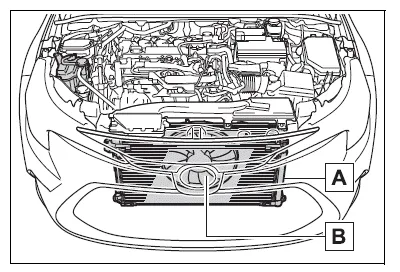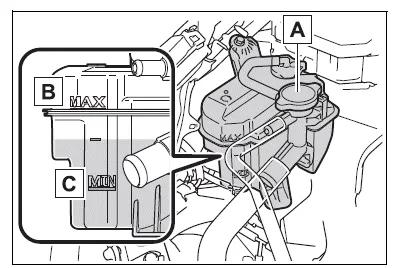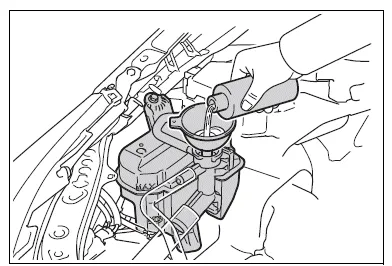Toyota Corolla (E210) 2019-2025 Owners Manual / When trouble arises / Steps to take in an emergency / If your vehicle overheats
Toyota Corolla (E210): If your vehicle overheats
The following may indicate that your vehicle is overheating.
- The engine coolant temperature
gauge is in the red zone or a loss
of engine power is experienced.
(For example, the vehicle speed does not increase.)
- "Engine Coolant Temp High Stop in a Safe Place See Owner's Manual" is shown on the multi-information display.
- Steam comes out from under the hood.
Correction procedures
1. Stop the vehicle in a safe place and turn off the air conditioning system, and then stop the engine.
2. If you see steam: Carefully lift the hood after the steam subsides.
If you do not see steam: Carefully lift the hood.
3. After the engine has cooled down sufficiently, inspect the hoses and radiator core (radiator) for any leaks.

- Radiator
- Cooling fan
If a large amount of coolant leaks, immediately contact your Toyota dealer.
4. The coolant level is satisfactory if it is between the "MAX" and "MIN" lines on the reservoir.

- Reservoir
- "MAX" line
- "MIN" line
5. Add engine coolant if necessary.
Water can be used in an emergency if engine coolant is unavailable.

6. Start the engine and turn the air conditioning system on to check that the radiator cooling fan operates and to check for coolant leaks from the radiator or hoses.
The fan operates when the air conditioning system is turned on immediately after a cold start. Confirm that the fan is operating by checking the fan sound and air flow. If it is difficult to check these, turn the air conditioning system on and off repeatedly. (The fan may not operate in freezing temperatures.)
7. If the fan is not operating: Stop the engine immediately and contact your Toyota dealer.
If the fan is operating: Have the vehicle inspected at the nearest Toyota dealer.
WARNING
■When inspecting under the hood of your vehicle
Observe the following precautions.
Failure to do so may result in serious injury such as burns.
- If steam is seen coming from
under the hood, do not open the
hood until the steam has subsided.
The engine compartment may be very hot.
- Keep hands and clothing (especially
a tie, a scarf or a muffler)
away from the fan and belts.
Failure to do so may cause the hands or clothing to be caught, resulting in serious injury.
- Do not loosen the coolant reservoir
cap while the engine and
radiator are hot.
High temperature steam or coolant could spray out.
NOTICE
■When adding engine coolant
Add coolant slowly after the engine has cooled down sufficiently.
Adding cool coolant to a hot engine too quickly can cause damage to the engine.
■To prevent damage to the cooling system
Observe the following precautions:
- Avoid contaminating the coolant with foreign matter (such as sand or dust etc.).
- Do not use any coolant additive.
Other materials:
Evap monitor (vacuum pressure monitor)
Notice:
a cold soak must be performed prior to conducting the drive pattern to complete
the internal pressure
readiness monitor.
Cold soak preconditions
The monitor will not run unless:
mil is off.
Fuel level is approximately 1/2 to 3/4.
Altitude is 7800 feet (2400 m) or less.
...
Content of driving information
■ Display items
Speedometer display/Driving
range
Fuel economy
Eco Driving Indicator/Driving
range
■ Speedometer display/Driving
range
Speedometer display
Driving range
Displays driving range with remaining
fuel. Use the displayed values
as a reference only.
This distance is computed ...
Precaution
1. Check that the battery cables are connected to the correct terminals.
2. Disconnect the battery cables when the battery is given a quick charge.
3. Do not perform tests with a high voltage insulation resistance tester.
4. Never disconnect the battery while the engine is running.
5. Check that ...


